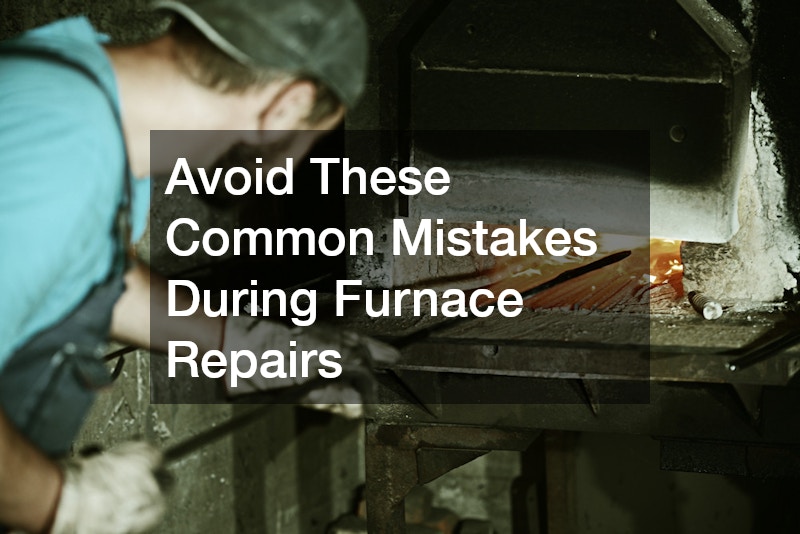Furnace repairs are a critical aspect of home maintenance that can affect both comfort and energy efficiency. However, homeowners often fall into common traps that can exacerbate issues instead of resolving them. Not only can improper fixes lead to inefficient heating, but they can also pose serious safety hazards. In this article, we aim to shed light on these pitfalls and provide guidance on how to avoid them for a more efficiently operated home furnace.
Why is my furnace not heating properly?
Check the Thermostat
A malfunctioning or wrongly set thermostat is often the culprit of insufficient heating. Ensuring the thermostat is adjusted correctly to the desired settings can resolve many heating issues without further intervention.
The first step in troubleshooting a thermostat issue is checking the battery and ensuring the device is connected to a reliable power source. If problems persist, verify that the thermostat is compatible with your HVAC system and properly calibrated.
In some cases, simply cleaning the thermostat or resetting it can restore functionality. It’s also essential to consider the placement of the thermostat to avoid erroneous readings caused by drafts or direct sunlight.
Inspect the Air Filter
A clogged air filter can significantly impact your furnace’s efficiency, leading to poor heating output and higher energy bills. Regular replacement or cleaning—typically every 1 to 3 months—can prevent this issue.
Dirty filters force the furnace to work harder, which can shorten its lifespan and cause parts to wear out prematurely. Maintaining a clean air filter is a simple step that enhances performance and ensures consistent airflow throughout your home.
Neglecting filter maintenance can result in a buildup of dust and particulates, potentially leading to respiratory issues for inhabitants. Monitoring filter condition and adhering to a maintenance schedule fosters a healthier indoor environment.
What should I do if my furnace is making strange noises?
Identify the Source of the Noise
Strange noises from a furnace, such as banging or rattling, may indicate underlying mechanical issues that need attention. Often, these sounds emerge from loose components or impending failures within vital parts.
Pinpointing the noise source can be challenging, but it is crucial for effective diagnosis. Common areas to investigate include the blower motor, fan belts, or heat exchanger, which, when damaged, tend to emit distinctive noises.
Ignoring these auditory warning signs can lead to more extensive and costly repairs. Early identification and resolution of noise-related issues can save both time and money in the long term.
Address Mechanical Problems
While some mechanical issues can be resolved with basic tools and a keen eye, others necessitate professional intervention. Understanding the complexity of each problem is key to determining the appropriate course of action.
Simple tasks such as tightening loose screws or replacing worn-out components can often be done by the homeowner. However, addressing more complex issues like motor failure or burner malfunctions should always involve a certified technician.
Attempting to fix complicated mechanical problems without proper expertise can lead to further damage and void warranties. Therefore, assessing the severity of the issue is crucial before proceeding with any repairs.
How can I improve my furnace’s efficiency?
Regular Maintenance Tips
Routine maintenance plays a significant role in sustaining furnace efficiency and reliability. This includes regularly inspecting key components and scheduling annual professional check-ups to ensure optimal performance.
Tasks such as cleaning burners, checking safety controls, and testing airflow can help preserve the furnace’s efficiency. These preventative actions not only enhance functionality but also extend the unit’s operational lifespan.
Incorporating maintenance into your routine saves energy and reduces operating costs over time. By doing so, you’re likely to avoid unexpected breakdowns during peak heating seasons.
Optimize Airflow and Ventilation
Proper airflow and ventilation are essential aspects of maintaining furnace efficiency. Ensuring vents and registers are unobstructed allows for optimal heat distribution throughout the home.
Regularly checking ductwork for leaks and blockages can further improve airflow and reduce energy waste. Efficient airflow minimizes strain on the furnace, which in turn lowers the risk of mechanical failures.
Improving ventilation increases indoor air quality and fosters a more comfortable living environment. Simple actions like keeping furniture away from vents can significantly enhance furnace performance.
What are the risks of DIY furnace repairs?
Safety Hazards
Undertaking DIY furnace repairs poses numerous safety risks, especially without appropriate knowledge or experience. Mishandling electrical connections or fuel lines can result in dangerous leaks or fires.
The risk of carbon monoxide poisoning is another significant hazard associated with improper furnace repairs. It is imperative to possess a fundamental understanding of furnace operations to mitigate these risks.
Adhering to safety guidelines and employing caution when working on a furnace can protect against severe accidents. When in doubt, consulting with a professional is the safest course of action to prevent harm.
Warranty and Insurance Implications
Unauthorised furnace repairs can have adverse implications on both warranties and insurance policies. Many manufacturers and insurers require repairs to be conducted by certified professionals to ensure coverage.
Performing unapproved adjustments can void warranty agreements, leading to out-of-pocket expenses for future repairs. Understanding the terms of your warranty and insurance policy can help avoid unwanted financial hurdles.
Prioritizing professional service ensures compliance with warranty stipulations. This, in return, safeguards your investment and assures peace of mind regarding your home’s heating system.
Avoiding common mistakes in furnace repairs is pivotal to maintaining an efficient and safe heating system. Ensuring regular maintenance, correctly diagnosing issues, and recognizing the risks of DIY repairs are key aspects of effective furnace management.
By adhering to professional advice and maintaining vigilance, homeowners can optimize their furnace’s performance and lifespan. Understanding and addressing these common pitfalls results in a safer, more cost-effective heating solution for your home.



